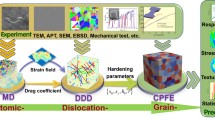Abstract
The evolution of the dislocation structure of the intermetallic compound Ni3Ge upon high-pressure torsion has been investigated. It has been determined that, under certain conditions, subsequent heating without loading leads to the self-locking of dislocations, while in other cases, this does not take place. The role played by the lattice distortions that arise under torsion is emphasized.
Similar content being viewed by others
References
B. A. Greenberg and M. A. Ivanov, “Some features of the formation and destruction of dislocation barriers in intermetallic compounds; I. Theory,” Phys. Met. Metallogr. 102, 61–68 (2006).
B. A. Greenberg, M. A. Ivanov, O. V. Antonova, N. A. Kruglikov, A. M. Patselov, A. V. Plotnikov, and Yu. P. Kadnikova, “Detection of dislocation self-locking effect in intermetallics,” Deform. Razrush. Mater., no. 12, 2–18 (2008).
B. A. Greenberg, M. A. Ivanov, O. V. Antonova, A. M. Patselov, A. V. Plotnikov, and A. M. Vlasova, “Dislocation blocking without help of external stress: Experiment and theory,” Usp. Fiz. Met. 14, 107–227 (2013).
B. A. Greenberg and M. A. Ivanov, “Strange behavior of dislocations of a certain type: Self-locking,” Russ. Metall. (Metally) 2016, 266–285 (2016).
B. A. Greenberg, M. A. Ivanov, O. V. Antonova, and A. M. Vlasova, “The first observation of dislocation blocking in pure metal without external stress,” Crystall. Rep. 57, 541–548 (2012).
B. A. Greenberg, M. A. Ivanov, O. V. Antonova, A. M. Patselov, and A. V. Plotnikov, “Deformation behavior of intermetallides: Models and experiments,” Israel J. Chem. 47, 415–421 (2007).
B. A. Greenberg and M. A. Ivanov, “Self-blocking of dislocations: A new concept,” Crystall. Rep. 54, 974–984 (2009).
B. A. Greenberg, M. A. Ivanov, and A. V. Plotnikov, “Reconstruction of dislocation potential relief by means od self-blocking effect,” Crystall. Rep. 55, 1025–1030 (2010).
B. A. Greenberg, M. A. Ivanov, O. V. Antonova, A. V. Plotnikov, N. A. Kruglikov, A. M.Vlasova, and Yu. M. Solovieva, “Self-blocking of dislocations in the intermetallic compound Ni3Ge: Reconstruction of a two-valley potential relief,” Phys. Met. Metallogr. 112, 203–212 (2012).
B. A. Greenberg, M. A. Ivanov, and A. M. Patselov, “Blocking and self-blocking of superdislocations in intermetallics,” TMS 2008 Ann. Meet. Suppl. Proc. 3, 165–170 (2008).
B. A. Greenberg and M. A. Ivanov, Intermetallic Compounds Ni3Al and TiAl: Microstructure, Deformation Behavior (Ural Otd. Ross. Akad. Nauk, Ekaterinburg, 2002).
P. Veyssière and G. Saada, “Microscopy and plasticity of the L12 ?' phase,” in Dislocations in Solids, Ed. by M. S. Duesbery and F. R. N. Nabarro (Elsevier, Amsterdam, 1996).
D. M. Wee and T. Suzuki, “Temperature dependence of the yield stress of Ni3Fe single crystals,” Trans. Japan Inst. Metals 22, 163–172 (1981).
A. V. Plotnikov, B. A. Greenberg, and A. M. Patselov, “Study of thermo-activated blocking of superdislocations in Ni superalloy (without external stress),” Proc.1st Int. School “Phys. Mater. Sci.”” Tol’yatti, 2004, p. 10.
V. A. Starenchenko, Yu. V. Solovieva, S. V. Starenchenko, and T. A. Kovalevdraya, Thermal and Deformational Hardening of Single Crystals of Alloys with an L12 Superstructure (Nauchn. Tekhn. Lit., Tomsk, 2006).
B. A. Greenberg, M. A. Ivanov, O. V. Antonova, A. V. Plotnikov, N. A. Kruglikov, A. M.Vlasova, and Yu. M. Solovieva, “Self-blocking of dislocations in intermetallic compound Ni3Ge: Cubic sliding,” Phys. Met. Metallogr. 111, 385–394 (2011).
V. I. Vladimirov, Physical Nature of Metal Fracture (Metallurgy, Moscow, 1984).
V. I. Vladimirov and A.R. Romanov, Disclinations in Crystals (Mauka, Leningrad, 1986).
A. N. Tyumentsev and I. A. Ditenberg, “Nanodipoles of partial disclinations in the region of localized elastic distortions,” Phys. Mesomech. 18, 158–162 (2015).
A. N. Tyumentsev, I. A. Ditenberg, A. D. Korotaev, and K. I. Denisov, “Lattice curvature evolution in metal materials on meso- and nanostructural scales of plastic deformation,” Phys. Mesomech. 116, 319–334 (2013).
A. D. Korotaev, A. N. Tyumentsev, and Yu. P. Pinzhin, “Activation of the mesolevel plastic flow in highstrength materials and characteristic types of defective substructures,” Phys. Mesomech. 1, 21–32 (1998).
Author information
Authors and Affiliations
Corresponding author
Additional information
Original Russian Text © A.V. Plotnikov, B.A. Greenberg, M.A. Ivanov, V.P. Pilyugin, T.P. Tolmachev, O.V. Antonova, A.M. Patselov, 2017, published in Fizika Metallov i Metallovedenie, 2017, Vol. 118, No. 8, pp. 843–850.
Rights and permissions
About this article
Cite this article
Plotnikov, A.V., Greenberg, B.A., Ivanov, M.A. et al. Is it possible for dislocations to self-lock after high-pressure torsion?. Phys. Metals Metallogr. 118, 802–809 (2017). https://doi.org/10.1134/S0031918X17080117
Received:
Accepted:
Published:
Issue Date:
DOI: https://doi.org/10.1134/S0031918X17080117




